Neoplan AN440
The Neoplan Transliner was a series of related public transport single-decker bus models introduced by Neoplan USA in 1981 and produced until the company declared bankruptcy in 2006. It was available in various lengths ranging from 26 ft (8 m) to 60 ft (18 m) articulated (nominal lengths), and was marketed against the Rapid Transit Series, Flxible Metro, Gillig Phantom, New Flyer High Floor, and Orion I.
| Neoplan Transliner | |
|---|---|
 A CNG-powered high floor AN440A operating in Albuquerque, New Mexico. | |
| Overview | |
| Manufacturer | Neoplan USA |
| Body and chassis | |
| Doors | 1, 2 or 3 |
| Floor type | Step entrance Semi low-floor Full low-floor |
| Chassis | Integral |
| Dimensions | |
| Length | 26 to 60 ft (8 to 18 m) |
| Width | 96 or 102 in (2 or 3 m) |
| Height | 3.0m |
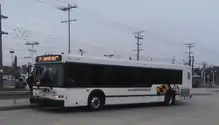
Models
The Neoplan USA Transliner was available in a wide variety of body styles. Transliner could be ordered in 26', 30', 35', 40', and 60' lengths. Standard (high), completely low, or semi-low (with steps to access the rear section after the rear doors) floors were available.
An unrelated over-the-road coach was marketed by Neoplan GmbH starting in the 1990s for the European market, also named Transliner.
| Nom. length | Std. (high) floor | Low floor | |
|---|---|---|---|
| Semi[lower-alpha 1] | Full | ||
| 26-foot | AN408 | ||
| 30-foot | AN430 | ||
| 35-foot | AN435 | AN435LF | |
| 40-foot | AN440 | AN440LF | AN440TLF |
| 45-foot | AN445TLF | ||
| 60-foot (artic.) |
AN460 | AN460LF | |
- Notes
- Low front section, high rear section behind rear doors.
Originally, the Transliner could only be ordered in standard (high) floor form. The low-floor variants were introduced in 1999, with Port Authority of Allegheny County (PAT) being the lead agency for mass-produced examples.[1] The "true low floor" variants (AN440TLF and AN445TLF) were also known as Intraliners, available in 40-and-45-foot-long (12 and 14 m) nominal lengths and mostly used by airports.[2]
Unique variants included the AN440LF-ETB trolleybuses produced for Massachusetts Bay Transportation Authority (MBTA), featuring a third passenger door on the street (driver's) side,[3] the DMA-460LF dual-mode buses for the Silver Line (MBTA) with trolley poles and a diesel engine, the AN440/3 3-axle variant with a dead third axle for Los Angeles County Metropolitan Transportation Authority (LACMTA), and the 1-foot (0.30 m) shortened AN460RC (aka AN459) built for New Jersey Transit (NJT).
.jpg.webp)
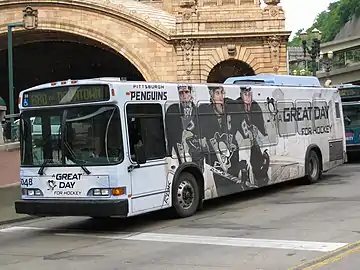 PAT #5048, AN440LF from first mass-produced order of low-floor Neoplan USA buses
PAT #5048, AN440LF from first mass-produced order of low-floor Neoplan USA buses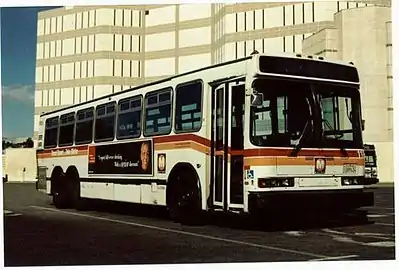 LACMTA #1185, AN440/3 3-axle suburban coach
LACMTA #1185, AN440/3 3-axle suburban coach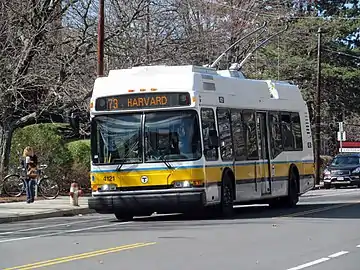 MBTA #4121, AN440LF-ETB trolleybus; note streetside door
MBTA #4121, AN440LF-ETB trolleybus; note streetside door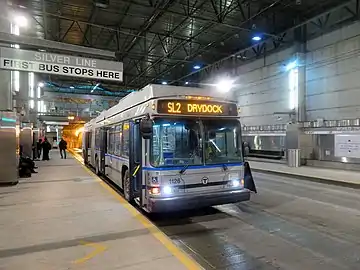 MBTA #1126, dual-mode DMA-460LF with trolley poles raised
MBTA #1126, dual-mode DMA-460LF with trolley poles raised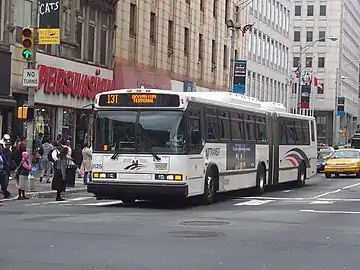 NJT #9525, shortened AN460RC (AN459)
NJT #9525, shortened AN460RC (AN459)
Design
| Transliner | Intraliner | |||||||||
|---|---|---|---|---|---|---|---|---|---|---|
| AN435[4] | AN435LF[5] | AN440[4] | AN440LF[5] | AN460[6][7] | AN460LF[8][9] | AN440TLF[10] | AN445TLF[10] | |||
| Dimensions | Length[lower-alpha 1] | 35 ft (11 m) | 40 ft (12 m) | 60 ft (18 m) | 40 ft (12 m) | 45 ft (14 m) | ||||
| Width | 96 or 102 in (2.4 or 2.6 m) | 102 in (2.6 m) | 96 or 102 in (2.4 or 2.6 m) | 102 in (2.6 m) | ||||||
| Height | 120 to 132 in (3.0 to 3.4 m) | 115 to 127 in (2.9 to 3.2 m) | 120 to 132 in (3.0 to 3.4 m) | 115 to 127 in (2.9 to 3.2 m) | 120 to 130 in (3.0 to 3.3 m) | 115 to 135 in (2.9 to 3.4 m) | 127 in (3.2 m) (max) | |||
| Wheelbase | 205.75 in (5.2 m) | ? | 266 in (6.8 m) | 274 in (7.0 m) | F: 209.19 in (5.3 m) R: 297.19 in (7.5 m)[lower-alpha 2] |
F: 222 in (5.6 m) R: 285.75 in (7.3 m) |
274 in (7.0 m) | ? | ||
| Drivetrain | Engines | DD S40 | ||||||||
| DD S50 | ||||||||||
| DD S60 | ||||||||||
| Cummins ISL | ||||||||||
| Cummins ISM | ||||||||||
| Cummins C Series | ||||||||||
| CAT C-9 | ||||||||||
| Transmissions | Allison World B400 or B500 | Allison World B500, ZF / Voith optional | ZF 5HP590 | |||||||
| Axles | Front | Neoplan IFS + Meritor axle hubs | Meritor FH-946 | Neoplan IFS + Meritor axle hubs | Meritor FH-946 | Neoplan IFS + Meritor axle hubs | Meritor, ZF or MAN optional | Meritor FH-946 | ||
| Middle | N/A | N/A | ||||||||
| Rear | Meritor 61000-series | Meritor RC-26-633 | Meritor 61000-series | Meritor RC-26-633 | Meritor 61100-series | Meritor RC-26-720 or ZF V9-65L-131 | ||||
- Notes
- Nominal
- AN460RC/AN459 is F: 237 in (6.0 m) and R: 253 in (6.4 m)
Construction
Self-supporting monocoque steel construction made of seamless square steel tubes, electrically welded. Exterior roof and side wall panels are of double galvanized steel, sealed to the skeleton with a combination of spot welding and gluing. Stainless steel wheelhousings and stepwells.[4][5][6][8]
Seating
Depending on the model and length, seats were offered for up to 37 (AN440LF),[5] 43 (AN440),[4] or 65 passengers (AN460/AN460LF).[6][8]
Engines
NeoPlan offered a variety of engines, both diesel and CNG fueled. Depending upon the model, Detroit Diesel Series 40, 50, or the 6V92TA; Cummins ISM, C-series, or ISL; or CAT C-9 engines could also be had. Most Transliners featured Allison B400 or B500 "World Transmissions". However, ZF (4HP590) and Voith transmissions were also available on some models.[4][5][6][8]
History
The first transit buses sold by Neoplan USA were based on the Neoplan N 416 buses developed for VöV under the Standard-Linienbus program. Accordingly, the first buses ordered from Neoplan USA were called the Atlantis[11]:4–101 and internally N-416-xx (with xx designating nominal length in feet); these were purchased by Metropolitan Atlanta Rapid Transit Authority (MARTA, 50× 40-foot models) and Milwaukee County Transit System (MCTS, 26× 40-foot and 18× 35-foot models) and delivered in 1981 and 1982.[12][11]:4–94 to 4–102
Neoplan USA was also offering the "Advanced Design" N412 bus to compete with the GM Rapid Transit Series and Flxible Metro.[11]:4–8;4–96;4–101 By 1982, these buses had been given the name "Transliner" and the model numbers had been established as the AN435 and AN440 (for American Neoplan, Model 4, 35 or 40-foot lengths, respectively). Significant early Transliner sales included 1,000 buses to 16 transit agencies in the state of Pennsylvania, coordinated by PennDOT in 1982, which was the largest single bus contract in the U.S. to date,[13][14] 50 articulated buses to MARTA,[15] 76 buses to Washington Metropolitan Area Transit Authority (WMATA) in 1983,[16] and 415 buses to LACMTA, then operating as the Southern California Rapid Transit District (SCRTD), in 1984 to support crowds expected for the 1984 Summer Olympics.[17]
Pennsylvania won a commitment from Neoplan USA to build an assembly plant in the state as a condition to fulfill the order; Neoplan USA announced its intent to add a Pennsylvania factory in 1982[18] and revealed a scale model of the site chosen in Honey Brook in 1984,[19] but assembled all of the Pennliners in Lamar due to the delivery deadlines.[20] The first bus completed for PAT, #3500, has been preserved by the Antique Motor Coach Association of Pennsylvania since March 2000.[21] Although the Honey Brook site assembled buses briefly in 1986, it would later become the headquarters of Neopart, Neoplan USA's part distribution operation. A third Neoplan USA factory operated for approximately a year from June 2001 to June 2002 in Brownsville, Texas.[22][23]
Issues
Joseph Alexander, a member of the WMATA board, criticized the 1983 contract award to Neoplan USA; Alexander was also serving as the president of the American Public Transportation Association (APTA), which had received negative feedback from MCTS. One MCTS official called Neoplan USA "totally disorganized" and lacking quality control.[16] Cracks were discovered in the frames of WMATA[24][25] and SCRTD buses in 1984,[26] and those agencies suspended service with their Neoplan USA buses in 1985,[27] just ahead of a nationwide voluntary recall in March.[28] That recall was also driven by a December 1984 incident where a faulty defroster on a WMATA bus led to an electrical fire and subsequent evacuation.[29]
The PennDOT buses, nicknamed "Pennliners", also were prone to premature corrosion,[30] as experienced by the Port Authority of Allegheny County (PAT).[21] Extensive corrosion issues led to a $1.7 million settlement between Neoplan USA and PAT in 1990.[1]
Another PAT order for low-floor AN440LF buses, which were delivered starting in August 1999, were pulled from service by September 2000 for frame cracks.[1] During federally mandated STURAA testing in 1994–95, a prototype AN440LF experienced extensive frame and suspension cracking.[31]:82–99 Neoplan USA entered an agreement to pay for all frame repairs to the low-floor models.[32][33] Multiple AN440LF buses delivered to the Massachusetts Bay Transportation Authority in 2005 were damaged by the same pothole; traveling over the pothole cracked the torque rods connecting the suspension and steering, and two crashes occurred as a direct consequence of steering issues.[34][35] Additional cracks in suspension components were discovered in 2006 and 2007.[36]
Deployment
The 40-foot buses were made for over 50 transportation networks all over the United States. The bus networks that have or have had them in service include MBTA in Boston, Massachusetts; SEPTA in Philadelphia, Pennsylvania; WMATA in Washington, D.C.; ABQ RIDE in Albuquerque, New Mexico and LACMTA in Los Angeles, California.
Pennsylvania
In late 1983 through 1985, Neoplan USA delivered the order for over 1,000 "Pennliner" buses for the state of Pennsylvania. The 1982 contract was a pooled purchase from 16 different transit agencies, with the majority going to SEPTA in Philadelphia (450) and Port Authority of Allegheny County (PAT) in Pittsburgh (410).[13]
Philadelphia
By 1989, SEPTA, the largest transportation network in Pennsylvania, had purchased a cumulative total of 1,092 Neoplan AN435 and AN440 buses.[37][38] As they aged, they were replaced by American Ikarus and New Flyer Low Floor buses that entered service between 1996 and 2005. The remaining 35 Neoplan AN440s (EZ models) were sent to the SEPTA Frankford Depot to temporarily replace the 1979 AM General Trolleybuses that were retired in 2004; the AN440s in turn were retired on June 20, 2008 after the final delivery of the replacement New Flyer E40LFR trolleybuses.[39]
SEPTA also ordered 155 Neoplan AN460s from 1998-2000 to replace their aging Volvo B10M articulated buses[40] and about 60 AN460 high floor buses were in service until 2017, when they were replaced by Novabus LFS Artic articulated buses.
Pittsburgh
PAT received its first Pennliners in October 1982;[41] the agency later ordered AN460s (articulated) and AN440LFs (low-floor) versions from Neoplan USA.
PAT retired its last two Neoplan buses (AN460s) in December 2019 by providing free rides around downtown Pittsburgh for one weekend.[42][43]
Washington, D.C.
In the 1980s, both PAT and WMATA, also known as Metro, discovered frame cracking issues with their Neoplan USA buses. However, they both later operated additional Neoplan buses, with WMATA ordering the AN460, a 60-foot articulated version.
San Francisco
AN440 and AN460 models were ordered by the San Francisco Municipal Railway (Muni) to replace their aging bus fleet and delivered starting in 2001, but they proved troublesome. Among the problems were insufficient, excessively noisy cooling fans (sounds reached up to 90 dB), faulty transmissions, maintenance intensive brake systems (requiring service every 5,000 miles (8,000 km)), and cracking frames. The problems were compounded when Neoplan eventually refused to fix the problems, instead choosing to repossess the remaining spare parts and abruptly abandon its San Francisco overhaul yard in September 2005.[44][45][46]
The Muni Neoplan USA buses are unique in that they have rear windows, with the air conditioning unit mounted on the roof.
St. Louis
Bi-State Development Agency, dba Metro, has a small fleet of Neoplan Buses for its MetroBus service, and since March 30, 2009, has retired them.
See also
References
- Grata, Joe (September 28, 2000). "Cracking in frames plagues 160 new buses". Pittsburgh Post-Gazette. P.G. Publishing Co. Retrieved 3 January 2019.
- "Manufacturer Neoplan to close early in 2006; competition takes toll" (PDF). Bus & Motorcoach News. December 1, 2005. Retrieved 23 November 2020.
- "NEOPLAN Electric Trolley Bus" (PDF). Neoplan USA. Archived from the original (PDF) on October 23, 2005.
- "AN440T". Neoplan USA. Archived from the original on October 29, 2000.
- "AN440L". Neoplan USA. Archived from the original on September 18, 2000.
- "AN460". Neoplan USA. Archived from the original on October 30, 2000.
- "NEOPLAN Articulated AN460" (PDF). Neoplan USA. Archived from the original (PDF) on October 23, 2005.
- "NEOPLAN Articulated AN460/LF" (PDF). Neoplan USA. Archived from the original (PDF) on January 15, 2006.
- "NEOPLAN Articulated AN460/LF CNG" (PDF). Neoplan USA. Archived from the original (PDF) on October 23, 2005.
- "AN440TLF". Neoplan USA. Archived from the original on October 30, 2000.
- Weiers, Bruce J.; Rossetti, Michael A. (March 1982). "4.8 NEOPLAN". Transit Bus Manufacturers' Profiles (Report). National Hightway Traffic Safety Administration. Retrieved 24 November 2020.
- Kristopans, Andre (October 5, 2014). "Neoplan USA". UtahRails.net. Retrieved 23 November 2020.
- Lizdas, Connie (March 9, 1982). "LCTA Urges Effort To Get Bus Builder". Citizens' Voice. wilkes-Barre, Pennsylvania. Retrieved 23 November 2020.
- "8-7-1982 - Blast from the Past - 1000 Neoplan Bus order in PA". Philadelphia Transit Vehicles [blog]. September 14, 2020. Retrieved 23 November 2020.
- Karr, Albert R. (November 12, 1981). "Buses That Bend, Hold 60% More Riders Ring Bell for Cost Savings Across Nation". Wall Street Journal. p. 8.
- Lynton, Stephen J (June 3, 1983). "Metro Board Member Protests Deal With Bus Firm". Washington Post.
- Merina, Victor (January 11, 1985). "More Cracks Found in RTD Bus Frames". Los Angeles Times. Retrieved 23 November 2020.
- "Bus firm may locate plant in Pennsylvania". UPI Archives. March 26, 1982. Retrieved 23 November 2020.
- Grata, Joe (April 21, 1984). "German bus firm turns on charm". Pittsburgh Press. Retrieved 23 November 2020.
- "The 80's at PAT". The Antique Motor Coach Association of Pennsylvania. Retrieved 23 November 2020.
- "Coach 3500: 1982 Neoplan AN440A". The Antique Motor Coach Association of Pennsylvania. Retrieved 23 November 2020.
- "Manufacturer Neoplan to close early in 2006; competition takes toll" (PDF). Bus & Motorcoach News. December 1, 2005. Retrieved 23 November 2020.
- Enguita v. Neoplan USA Corp. (S.D. Tex. December 2, 2005).Text
- Lynton, Stephen J (March 9, 1984). "Transit Authority Locates Hairline Cracks on 32 Buses". Washington Post. p. B3.
- "Cracks found in D.C. buses; no problems here". Green Bay Press-Gazette. AP. March 10, 1984. Retrieved 23 November 2020.
- Sappell, Joel (October 2, 1984). "Cracks Force New RTD Buses to Make Pit Stops". Los Angeles Times. Retrieved 23 November 2020.
- Lynton, Stephen J (February 13, 1985). "Metro Halts Use of All Neoplan Buses". Washington Post. p. A1.
- UPI (March 22, 1985). "Neoplan Recalls Defective Buses". United Press International.
- Lynton, Stephen J (February 12, 1985). "8 More Metrobuses Idled With Cracks". Washington Post. p. D1.
- Kirkpatrick, Rich (June 1, 1989). "Pa. House panel approves bill to study bus problems". The Gettysburg Times. AP. Retrieved 23 November 2020.
- STURAA TEST: 12 Year 500,000 Mile bus from Neoplan, Model AN 440L | PTI-BT-R9411-13 (PDF) (Report). The Pennsylvania Transportation Institute, Bus Testing and Research Center. May 1995. Retrieved 23 November 2020.
- Editorial (January 24, 2001). "Uncracking the Case; Good News About Buses That Developed Fractures". Pittsburgh Post-Gazette. P.G. Publishing Co. p. A10.
- Grata, Joe (October 23, 2000). "Port Authority Buses Showed Signs of Frame Problems in Pre-Purchase Tests". Pittsburgh Post-Gazette. P.G. Publishing Co. Retrieved 3 January 2019.
- Daniel, Mac (July 19, 2005). "MBTA set to replace damaged bus parts". The Boston Globe. Retrieved 23 November 2020.
- "Monster pothole ruining Boston buses". UPI Archives. July 19, 2005. Retrieved 23 November 2020.
- Daniel, Mac (April 25, 2007). "T wrestles again with cracks in its buses". The Boston Globe. Retrieved 23 November 2020.
- "History of the Neoplan 40 foot bus (AN440) throughout the streets of Philadelphia". Philadelphia Transit Vehicles. Retrieved 24 November 2020.
- "History of the Neoplans (Part IV): Order Numbering Details". Philadelphia Transit Vehicles. Retrieved 24 November 2020.
- "History of the Neoplans (Part III)". Philadelphia Transit Vehicles. Retrieved 24 November 2020.
- "The History Of The Neoplan Order". Philadelphia Transit Vehicles. Archived from the original on November 20, 2007.
- "Good News for PAT Riders: New Buses Start Rolling In". The Pittsburgh Press. October 26, 1982. Retrieved 23 November 2020.
- "Port Authority Ends Use Of Neoplan Buses, Offers Weekend Free Bus Ride". CBS Local News. December 7, 2019. Retrieved 24 November 2020.
- "Last hurrah: Port Authority offers free weekend rides in Downtown Pittsburgh on buses being retired". Pittsburgh Post-Gazette. December 6, 2019. Retrieved 24 November 2020.
- Matier, Phil (October 3, 2005), "Commissioner wants probe of police union chief", San Francisco Chronicle, retrieved December 27, 2007
- Epstein, Edward (February 8, 2001), "Muni's 'Screaming Banshees' Costing City Folk Sleep", San Francisco Chronicle, retrieved December 27, 2007
- Matier, Phil (January 20, 2003), "Wayward nuts put Muni in a bind over new coaches", San Francisco Chronicle, retrieved December 27, 2007
Bus test reports
- STURAA Test: 12 year, 500,000 mile bus from Neoplan, Model Articulated LNG | PTI-BT-R9308 (Report). The Pennsylvania Transportation Institute, Bus Testing and Research Center. April 1993.
- STURAA Test: 12 year, 500,000 mile bus from Neoplan, Model AN440 CNG/Diesel | PTI-BT-R9315 (Report). The Pennsylvania Transportation Institute, Bus Testing and Research Center. July 1993.
- STURAA Test: 12 year, 500,000 mile bus from Neoplan, Model AN440L | PTI-BT-R9411-13 (Report). The Pennsylvania Transportation Institute, Bus Testing and Research Center. May 1995.
- Partial STURAA Test: 12 year, 500,000 mile bus from Neoplan, Model AN440 | PTI-BT-R9416-P (Report). The Pennsylvania Transportation Institute, Bus Testing and Research Center.
- Partial STURAA Test: 12 year, 500,000 mile bus from Neoplan, Model AN440L | PTI-BT-R2016-03-01-P (Report). The Pennsylvania Transportation Institute, Bus Testing and Research Center. March 2001.
- Partial STURAA Test: 12 year, 500,000 mile bus from Neoplan, Model AN460 | PTI-BT-R0108 (Report). The Pennsylvania Transportation Institute, Bus Testing and Research Center. September 2001.
- STURAA Test: 12 year, 500,000 mile bus from Neoplan, Model AN460RC | PTI-BT-R0314 (Report). The Pennsylvania Transportation Institute, Bus Testing and Research Center. December 2003.
- STURAA Test: 12 year, 500,000 mile bus from Neoplan, Model AN460 DMA (Dual Mode) | PTI-BT-R0413 (Report). The Pennsylvania Transportation Institute, Bus Testing and Research Center. June 2005.